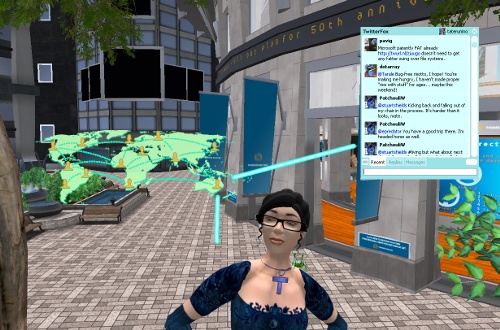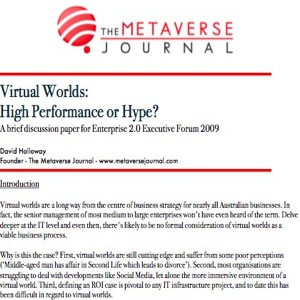1. The latest Second Life Education in New Zealand blog has an interesting update on a NZ-based Second Life creative project that’s exploring issues around public urban spaces.
2. Volume 3 of the Journal of Virtual Worlds Research is now available and as usual contains a range of interesting research. A glimpse of some of the peer-reviewed research papers:
Spectacular Interventions of Second Life: Goon Culture, Griefing, and Disruption in Virtual Spaces Burcu S. Bakioglu Abstract | PDF
Knee-High Boots and Six-Pack Abs: Autoethnographic Reflections on Gender and Technology in Second Life Delia Dumitrica, Georgia Gaden Abstract | PDF
Jigsaw Worlds and Avatars – Puzzling Over Property and Personhood. New Challenges for Intellectual Property Law. Norberto Nuno Gomes de Andrade Abstract | PDF
On the Dark Side: Gothic Play and Performance in a Virtual World Mikael Johnson, Tanja Sihvonen Abstract | PDF
Analyzing Social Identity (Re) Production: Identity Liminal Events in MMORPGs Javier A Salazar Abstract | PDF
Gorean role-play in Second Life Tjarda Sixma Abstract | PDF
“Because it just looks cool!†– Fashion as character performance: The Case of WoW Susana Tosca, Lisbeth Klastrup Abstract | PDF
Things you can do in a virtual game world, when you are dead: collective memory constitution and identity of virtual refugees. Anthony Papargyris, Angeliki Poulymenakou Abstract | PDF
3. The Virtual Worlds: High Performance or Hype? discussion paper is still available as a free download.

 Today, I had the pleasure of facilitating four small group sessions at the
Today, I had the pleasure of facilitating four small group sessions at the Aside from the group discussions on virtual worlds I facilitated yesterday, the only other time I witnessed them discussed at the
Aside from the group discussions on virtual worlds I facilitated yesterday, the only other time I witnessed them discussed at the  If you’re a Mac user, you know you’ve got access to a whole slew of first-class applications. That is, apps that follow the user-interface style guidelines for the Mac. Painstakingly developed and tested over time, the guidelines ensure consistent layouts of menus, options and hotkeys, so that you don’t spend your time struggling to work out how to do the familiar, when you should be getting on with gaining expertise in the unfamiliar.
If you’re a Mac user, you know you’ve got access to a whole slew of first-class applications. That is, apps that follow the user-interface style guidelines for the Mac. Painstakingly developed and tested over time, the guidelines ensure consistent layouts of menus, options and hotkeys, so that you don’t spend your time struggling to work out how to do the familiar, when you should be getting on with gaining expertise in the unfamiliar. NoviCraft is one of the more fascinating virtual world business offerings by Finnish company,
NoviCraft is one of the more fascinating virtual world business offerings by Finnish company,
Recent Comments